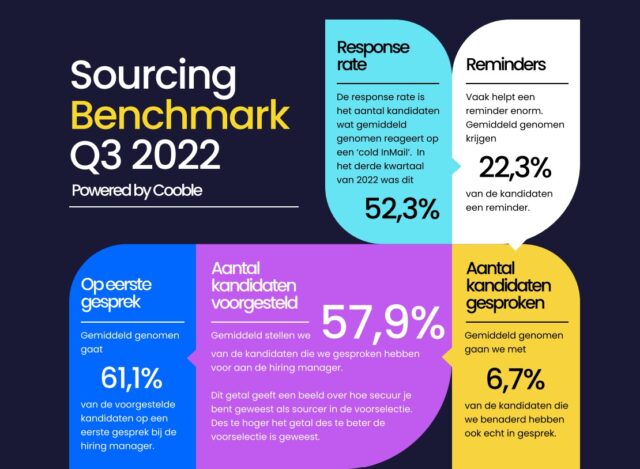
Anyone who approaches candidates themselves is mainly interested in the response rate . This number determines how many messages you have to send before there is a response from a potential candidate. The more responses you receive to your messages, the better, of course. And from the third Sourcing Benchmark that the specialized agency Cooble recently published, sourcers appear to be getting better at this on average. While the response rate was 51.7% in the second quarter of this year , it increased to 52.3% in the third quarter of this year .
‘An average response rate is between 35% and 45%, anything above that is excellent.’
An average response rate is between 35% and 45% , anything above that can be called excellent, says Cooble. And therefore a score of more than 52%. “More and more candidates are open to an introduction,” the researchers conclude, who advise others to increase the response rate by making messages more personal. ‘For example, research the candidate. This gives you 15% more chance of a response instead of a general message.’ They also recommend that you feel free to send reminders to candidates.
‘Do good research’
The number of candidates with whom Cooble spoke after a message has increased very slightly compared to the second quarter: they now speak to an average of 6.7% . Of all those candidates spoken to, an average of 57.9% are then presented to the hiring manager, which is a slight decrease compared to the previous quarter. Do you want to keep this percentage high? Then the Cooble researchers advise: ‘Do thorough research into matching candidates. You can lose a lot of time if you don’t handle this properly.’
Of the candidates who had an initial interview, 55.5% advanced to the second round.
The figures for candidates presented for a first interview are quite comparable to the previous quarter: 61.1% . It is important to keep this number high, says Cooble: ‘This ensures that the candidates approached better meet the needs of the hiring manager .’ Of the candidates who had an initial interview, 55.5% went on to a second round. More than half have been invited to a follow-up interview, which is also a considerable increase compared to the previous quarter.
Manage expectations
In the current tight labor market, it is important to respond quickly and guide candidates through the process smoothly, the researchers say. ‘Manage your candidates’ expectations and respond quickly if a follow-up interview needs to be scheduled.’ And that speed is also important for the final part of the sourcing process: the hiring process.

The Benchmark shows that in the third quarter 42.2% of candidates received an offer, after which 26.1% did not accept this offer, an increase compared to the previous quarter. Ultimately, 84.7% of all candidates accepted the employment conditions offer, which was a significant increase compared to the second quarter (when this was still 78% ).
‘Salary plays a very important role at the moment.’
In addition to the figures , the Benchmark also offers some more general findings. For example, the sourcers note that the sourcing instrument is becoming increasingly effective, even in professions where it was not used much before. In other words: everything outside the difficult IT and technical functions. ‘We are now also seeing better performance for the more operational roles.’ They also notice that inflation is taking its toll. ‘Salary plays a very important role at the moment. Candidates who have really improved their employment conditions are now more likely to take on another job.’
Knowing more?
Download the entire Benchmark, with all figures and findings:



